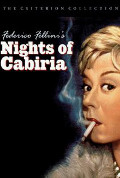
USA 1957
Directed by
Federico Fellini
110 minutes
Rated PG
Reviewed by
Bernard Hemingway

The Nights Of Cabiria
Fellini capitalizes on the success of La Strada from three years earlier by casting his wife, Giulietta Masina, as Cabiria, a prostitute whose irrepressibly dreamy optimism is constantly being disappointed by harsh fate. The film opens with her being pushed in a river by her pimp who runs off with her handbag. We then follows her on a series of adventures as she gets picked up by a matinee idol who takes her back to his mansion, joins a pilgrimage to the Shrine of the Virgin Mary, visits a magic show, meets an accountant who proposes to her and oscillates between her makeshift home on Rome’s outskirts and the strip where she plies her trade with other ladies of the night.
Masina’s signature Pierrette character which worked so well in La Strada is less effective here, never remotely approaching credibility as a career prostitute, not that this was ever Fellini’s intention. Moving a long way from his roots in neo-realism, Fellini takes subject matter which from that perspective would be considered a social issue (the streets scenes are probably the work of Pier Paolo Pasolini who has a script-writing credit) and uses it as a pretext for his distinctive brand of tragic-comic whimsy. All the features of the director’s mature style are here – the grotesque characters, the petty thieves and pimps, the religious personnel, cheap illusionism and of course, Rome itself. From this perspective the film is enjoyable particularly thanks to Masina’s performance, but falling between the perfect balanced benchmark of La Strada and the tawdry reality that lies behind its subject matter, Le Notti di Cabiria's optimism seems more head in the sand than head in the clouds.
Want something different?





